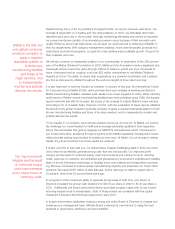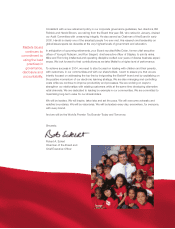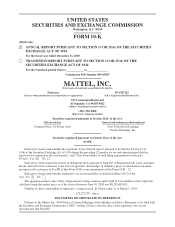Mattel 2003 Annual Report Download - page 15
Download and view the complete annual report
Please find page 15 of the 2003 Mattel annual report below. You can navigate through the pages in the report by either clicking on the pages listed below, or by using the keyword search tool below to find specific information within the annual report.The foreign countries in which most of Mattel’s products are manufactured (principally China, Indonesia,
Thailand, Malaysia and Mexico) all enjoy permanent “normal trade relations” (“NTR”) status under US tariff
laws, which provides a favorable category of US import duties. China’s NTR status became permanent on
January 1, 2002, following enactment of a bill authorizing such status upon the country’s accession to the World
Trade Organization (“WTO”), which occurred in December 2001. Membership in the WTO substantially reduces
the possibility of China losing its NTR status, which would result in increased costs for Mattel and others in the
toy industry.
All US duties on toys were completely eliminated upon implementation of the Uruguay Round WTO
agreement in 1995. The European Union, Japan and Canada eliminated their tariffs on most toy categories
through staged reductions that continued through January 1, 2004. The primary toy tariffs still maintained by
these countries are EU and Japanese tariffs on dolls of 4.7% and 3.9%, respectively, and a Canadian tariff of 8%
on children’s wheeled vehicles.
Virtually all of Mattel’s raw materials are available from numerous suppliers but may be subject to
fluctuations in price. Mattel has long-term agreements in place with major suppliers that allow the suppliers to
pass on only their actual raw material cost increases.
Competition and Industry Background
Competition in the toy industry is intense and is based primarily on price, quality and play value.
The Mattel Brands US and Fisher-Price Brands US segments compete with several large toy companies,
including Hasbro, Inc., Jakks Pacific, Lego, Leap Frog, Bandai, MGA Entertainment and many smaller toy
companies. American Girl Brands competes with toy companies in the doll category, and to a lesser extent, with
children’s book publishers and retailers in the girls category. Mattel’s International segment competes with
global toy companies including Hasbro, Lego, Tomy, Bandai, and other national and regional toy companies.
Foreign national and regional toy markets may include competitors who are strong in a particular toy line or
geographical area, but do not compete with Mattel and other international toy companies worldwide.
Additionally, in recent years, several large retailers have offered competing products under their own private
labels.
Seasonality
Mattel’s business is highly seasonal, with consumers making a large percentage of all toy purchases during
the traditional holiday season. A significant portion of Mattel’s customers’ purchasing occurs in the third and
fourth quarters of Mattel’s fiscal year in anticipation of such holiday buying. These seasonal purchasing patterns
and requisite production lead times cause risk to Mattel’s business associated with the underproduction of
popular toys and the overproduction of toys that do not match consumer demand. Retailers are also attempting to
manage their inventories more tightly, requiring Mattel to ship products closer to the time the retailers expect to
sell the products to consumers. These factors increase the risk that Mattel may not be able to meet demand for
certain products at peak demand times, or that Mattel’s own inventory levels may be adversely impacted by the
need to pre-build products before orders are placed. Additionally, as retailers manage their inventories, Mattel
experiences cyclical ordering patterns for products and product lines that may cause its sales to vary significantly
from period to period.
In anticipation of retail sales in the traditional holiday season, Mattel significantly increases its production
in advance of the peak selling period, resulting in a corresponding build-up of inventory levels in the first three
quarters of Mattel’s fiscal year. Seasonal shipping patterns result in significant peaks in the third and fourth
quarters in the respective levels of inventories and accounts receivable, which result in seasonal working capital
financing requirements. See “Seasonal Financing.”
6
























